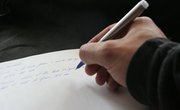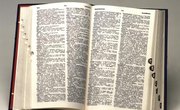What are Adjectives that Describe Texture?
Used to describe people, places and things, otherwise known as nouns, adjectives add life, flair and interest to sentences in English. Because texture is such a broad description of the characteristics of people, places and things, it's necessary to categorize the many adjectives that can be used to describe exactly how something feels when it's touched. The adjectives will also lend a richness to your students' writing. Adjectives are the opposites of adverbs, and can be used as texture words and many other uses.
Adjectives that End in "y"
Words that end in "y" can help describe how a noun looks, and many of those same words can also be used to describe how the noun feels when touched. For example, "bumpy" describes a rough texture, "slippery" describes a smoother texture and "fuzzy" describes a soft texture. Other adjectives that can be used for a rough texture include pokey, craggy, seedy, grainy, lumpy, gritty, rocky and bristly. Additional adjectives that can be used for a smooth texture include glossy, silky, satiny, syrupy, filmy, runny, waxy, velvety, slimy, crumbly and creamy. Cottony, bushy, furry, hairy, fluffy, wooly, soapy, feathery, wooly, buttery, chewy, spongy, bubbly and puffy are all adjectives that effectively describe soft textures.
Adjectives that End in "ed"
Adding an "ed" to a verb can be an effective way to find adjectives to describe how an item feels when it's touched. For example, the word "etched" indicates that the item has been scratched with certain markings. "Distended" is another example and it suggests that the item is swollen or fat. Blemished, blistered, bloated, potholed, ribbed, flawed, pressed, caked, indented, pockmarked, scraped, tarnished and scored are all adjectives that can indicate that the texture of an object is somehow damaged. Adjectives that suggest that an item has a pleasant texture include unaltered, smoothed, polished, decorated and unsoiled.
Miscellaneous Adjectives
Beyond the traditional notion of what texture is, there are numerous words that can be used to tell others exactly what one is feeling when she touches something. For example, bald can be used to tell about the texture of how someone's head feels if no hair is growing and flat can be used to describe how a piece of floor tile feels on the bottom of the feet. Moist is a word that suggests the way a damp swimsuit feels when it's put on before completely drying. Sleek might be used to indicate the way a brand new sports car feels when one runs her hand down the brand new metal. Granular and pliable are other descriptive words for textures.
Taste Adjectives
Adjectives that describe the way foods feel are a bit different than adjectives that describe how something feels when someone touches it. For example, ice cream could be described as creamy, icy, smooth and soft, while pizza could be described as doughy and gooey. Additional adjectives that describe the texture of food and drink include crispy, crunchy, juicy, mushy, salty, creamy, flaky, frothy, spicy and fizzy. Glutinous is another example of taste.
Related Articles
References
Writer Bio
Sara Ipatenco has taught writing, health and nutrition. She started writing in 2007 and has been published in Teaching Tolerance magazine. Ipatenco holds a bachelor's degree and a master's degree in education, both from the University of Denver.










